

Aircraft Engine Company Publications
by Bill Lewis
Published 20170109
|
There are many WWII-era company titles that have similar content — very little technical information or company activity details due to government, military or company-imposed censorship. Who wanted to see inside a factory or the machinery that an employee used in 50-hour production workweek anyway? Some are good for researching family members' stories (Did Uncle Harry really hit that home run for the company baseball team in June 1943, and then get drafted that July? He always talked about the home run but didn’t mention his military service!) Employees generally picked up this type of company publication on the way out of the gate when going home or received them by mail at their homes. They were typically never given out on the way into work as the company didn’t want production lost or slowed due to employees reading even a few pages on company time! Most employee-type magazines stopped at end of WWII production as companies then didn’t have any material on how the war was being won or why one should buy war bonds, especially when thousands of employees were now just hundreds or even zero with gates closed. There were a few companies that manufactured aircraft or automobiles along with aircraft engines; Rolls-Royce, de Havilland, Napier, and Renault are examples. Unfortunately, none of these had separate publication for their aircraft engine business or had no aircraft engine material in their publications. Lewis has not collected such publications and none of their titles appear here. Those interested in researching aircraft engine company publications should begin by consulting Aeronautical and Space Serial Publications; A World List, which was published by the Library Of Congress in 1962. A second good reference is Aeronautical Engineering Review May 1946 pages 118 – 123. These form a starting point for research, but are neither complete nor entirely accurate. Although they list titles, they do not provide information on content, size, binding, page count, etc. Some of the titles can be found on eBay and other Internet sites. Buyers should try to purchase at least 50-75% of the issues per year or volume on first buy. Although one might pay more with this method it avoids a lot of duplicate issues. |
The listing format used for the titles below below is as follows:
Company: Title or Titles. Publication Dates and Frequency, Size, Page Count.
Remark(s).
Size Codes
A4 = 8.5” x 12”
4qto = 8” x 10”
8vo = 6” x 8”
Legal = 8” x 14”
American Titles
Allison Service Division: Tailspins. May 1943 to July 1945, monthly, 8vo, 20-30 pages with color covers.
Has material seen no where else, even in the company manuals! Good source for service engineers' names and duty movements, oldest V-1710-33 engine and number still in service in 1944. Has hints on maintenance, such as why the British Lockheed 322 (P-38) engines were giving trouble.
 |
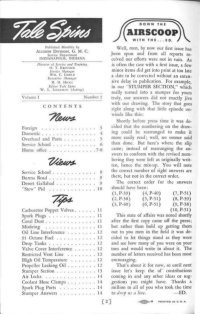 |
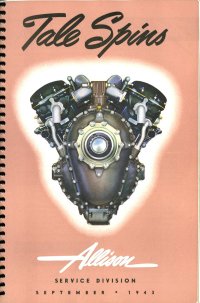 |
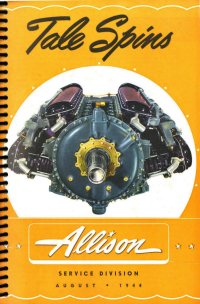 |
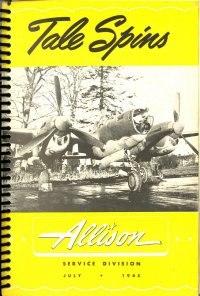 |
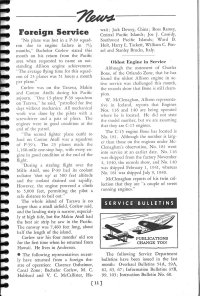 |
 |
 |
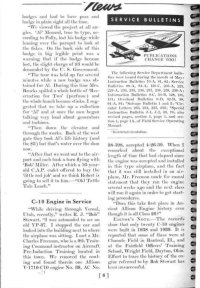 |
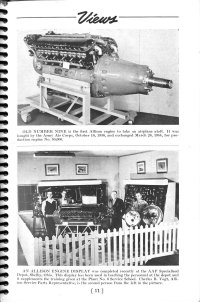 |
| These sample images are representative of the other titles below, which require AEHS membership to view. | ||||
Chandler-Evans: The Air Box. August 1942 to 1945, quarterly, 4qto, early issues were 8 pages, later ones 20 pages.
The first issues had black and white illustrated covers; later ones had blue covers but the photo illustrations were still black and white. If one is looking for details on Chandler-Evans Ceco carburetors and fuel pumps used on R-3350 engines in B-29s, this is not it! The publication is devoted to employee activities, with very little on company production.
Curtiss-Wright Propeller Division: Bladesman. May 1941 to Summer 1945?, semi-monthly until 1945 then quarterly, 4qto, 20-30 pages per issue.
Covers were always in color. Bladesman was a public-relations publication pre-WWII, then employee-related with information on how the production war was being won. There is some solid information here. Collectors should beware of WWII issues because the color rear covers were often torn/cut off for framing and may be missing.
Curtiss-Wright: The Tradewind. July 1929 to December 1931, 4qto, 15+ pages.
Previously The Wright Engine Builder. The title changed with the Curtiss-Wright merger of 5 July 1929.
Curtiss-Wright: Curtiss-Wright Review. January 1932 to March 1934?, monthly, 4qto except January 1932, which was legal-size, 15+ pages.
Curtiss-Wright: Sales and Service Newsletter. April 1934 to August 1934 (five issues), 4qto, 15+ pages.
Curtiss-Wright: Trade Winds. October 1934 to 1947, monthly, 4qto, most 20+ pages.
In March 1941 covers went to red photo covers and the title script was changed. The May 1936 issue started the Kenneth Boedeckers “Purely Personnel” column, located on the inside of rear cover. This column included snapshots aviation people, famous and otherwise. Bodecker was the Engine Service Engineer who tuned Lindberg’s Spirit of St. Louis engine. He also may have been the only passenger that Lindberg ever carried in The Spirit, as it was a single seat aircraft! Trade Winds, along with Pratt & Whitney's Bee-Hive had world-wide in distribution. The pre-war issues are the best for content.
Fairchild: Aviation News. Intermittently published from April 1929 until 1938, 4qto, 15+ pages.
A total of 15 to18 issues, all numbered and dated, were published. Only the middle 1930s issues have some engine material as most was dedicated to aircraft. See American Aviation Historical Society Journal Vol. 45 (2000) page 22 for a history of this publication, along with the later Pegasus title.
Fairchild (Ranger): Cloud Buster. 1945, oblong 4qto coil bound with yellow board covers, 80 pages.
This annual has WWII-era digests/reprints from earlier issues of the same title. It may have been published at end of engine production in 1945 and given as a Ranger employment memento. It has some interesting material on manufacturing including management personnel hire dates, length of service, and photographs with various VIPs that visited.
Jacobs: Plane Power. June 1943 to 1946, monthly, 4qto, 14 pages until 1946, then 8 pages.
All covers have a red outline with the company logo in the left lower corner. This is nearly all employee activities with very little on engine production. Jacobs beauty queens are still good looking, however!
Kirkham: The Kirkham News. April 1935 and July 1935 are the only known issues, 4qto, 8 pages.
Charles B. Kirkham started in the aircraft engine business at Bath, New York during 1909. When his company failed in 1915 he went to Curtiss, where he put the -5 on the OX. He and Arthur Nutt also designed the first modern V-12 monoblock engine at Curtiss in 1918, an engine that became the D-12. The Kirkham News was all historical in nature, with photographs of Kirham’s early aeronautical work. This is the type of material that is important!
Lycoming: The Lycoming Star. January 1939 to 1945?, monthly, mostly 4qto 4-page self-mailer.
Pre-war issues were public relations, but in 1943 it became more employee human interest related. Good material here.
Lycoming: The Lycoming Starduster. October 1941 to 1945?, monthly, mostly 4qto, 8 pages.
All-employee publication. The August 1943 issue featured a photo of women in coveralls taken at Lycoming in 1918, and another current photo of the same women in more modern coveralls! This title still OK, however!
Pratt & Whitney: The Bee-Hive. January 1927 through today, monthly to 1945, 4qto, 15+ pages.
This title, along with Boeing Magazine & Airliner, is more than likely the only company publication most aircraft engine enthusiasts have ever seen; both had long runs. The Bee-Hive is public relations, devoted to promoting company engines. From the first issue it has had little employee chit-chat, the closest being a late 1920s issue with a company picnic photos. The Bee-Hive had world-wide in distribution! Naturally, the pre-war issues have the best for content.
Pratt & Whitney Missouri: The Wasp Nest. February 1943 to 1945, monthly, 4qto, 20+ pages.
Employee news and war-effort status, but not many details on the R-2800 engines manufactured in Missouri. The Wasp Nest, however, had very good employee photographs.
Wright Martin: Aircraftings. 1918 to 1919? Weekly legal-sized off-white paper, 16p pages.
Employee paper with nothing on the license-built Hispano-Suiza engines in Issue # 34 dated 14 December 1918, which is the only one I have.
Wright Aero: The Wright Aircraft Builder. 1920 to June 1926, 4qto except the January 1932 issue, which is legal-sized.
The title change to The Wright Engine Builder for July 1926 to June 1929, and then to The Tradewind after the Curtiss-Wright merger. All these titles are for public relations, advertising reliable Wright engines now flying the world over! I really like this title; very good material.
British Titles
Armstrong Siddeley: The Armstrong Siddeley Air-Mail. June 1929 to July 1933. Monthly, then bimonthly in 1930. A4 , 20-40 pages.
All covers were the same with no dates. There were English, French, Spanish, and in February 1933, an all-German edition. These had the same material as English editions. The publication was mainly composed of company aircraft news, with some general aircraft industry news also. With its dark cream paper, small type, and small dark photos or hand drawings, this title is example of how not to do a company publicity publication.
Bristol Aeroplane Co. The Bristol Review Engine Issue. 1930 to May 1939, 15 issues, 2 per year, 4qto 30+ pages.
Covers on the first three issues are the same other than color with no dates. “Engine Issue” was added to title starting with the fourth issue; all covers were now red with photo. This is how an engine company publication should be, one of the very best for material on Bristol aircraft engines. It includes record flights with technical details on the engines. There was a separate “Aircraft Issue” from December 1930 to 1939, which was also just as good as the Engine Issues. Needless to say this title is one of my favorites!
Czech Titles
Walter: Bulletin Walter. 1928 to 1939. 10 issues yearly, A4.
The 1929 and 1930issues were four pages each and were part of a French language publication Le Mois Aerontique, published in Czechoslovakia. The publication was in Czech, French, and English; later in 1930s just Czech and French. Issues after the French magazine supplement all have color card covers that changed every year. This is a high-quality publication with automobile articles on the company cars. The issues that were published for the Paris France Aircraft Salon (every two years) have 50+ pages, include English text and are wire-coil bound to a very high standard, with color plates and no expense spared on the effort. Issues other than those from 1928 to 1930 all have aircraft-related advertisements at the rear.
French Titles
All of the French aircraft engine company titles are of high quality, and it is clear that a great deal of time and effort was put into them. All the titles are publicity / public relations with some titles having aviation-related advertisements at the rear. All titles list the latest long range / record voyages and mention their engines.
Gnome-Rhone: Gnome Rhone Journal. December 1927 to 1940. 68 issues.
Numbers 1 through 37 are 4qto; all the other numbers are A4 20-50+ pages in later issues. Issue #42 was titled Air Journal for one number only. Numbers 43 through 68 were titled PleinCiel and have card covers. These include articles on company motorcycles and humorous cartoons on the rear covers. Some PleinCiel-titled issues have English inserts, but I have no idea whether they all did! The company rotary engines were obsolete with no market because of the broad availability of WWI surplus material. To stay in the aviation business the company purchased the Bristol Jupiter radial engine license in 1922. Until the late 1920s Gnome-Rhone engines are just refinements of the basic Bristol Jupiter, but from the early 1930s engines were designed by Gnome-Rhone.
Hispano-Suiza Paris: Revue a Bulletin Technique de la Societe Francaise Hispano-Suiza. 1925 to 1935. A4, 10-50+ pages.
Published twice a yearly except 1931 and 1935, which have only a single issue per year. April 1932 was the first issue with card covers. They contain very little auto / marine material and have no English supplements that I know of, nor any English in any issues! There were no Hispano-Suiza publications for 1936 and 1937. From Paris Hispano-Suiza company, this title is delightful!
Hispano-Suiza Paris: Revue Technique Hispano-Suiza. Juillet 1938 to Juillet 1939, 5 issues, A4, 40+ pages.
All have heavy card color covers with issue number and date on the covers. All five issues have color art plates printed on one-sided heavy paper with aircraft using H-S engines; one has to “page” on purchase to be sure the plates are all present. This H-S title is different in content from above title with much more technical material.
Potez: Bulletin Technique des Avions H. Potez. January 1929 to 4th quarter 1936. 4qto, 20-40+ pages.
Includes three special issues of 32+ pages. All have color card covers and some have fuzzy-type covers on the record flights. Potez purchased the Anzani engine company in 1930, so all the Potez company engines are Anzani-based. This is a superior publication full of construction drawings and other detailed material. All issues in French with no English. I understand this publication has been reprinted, but I have no details about whether all issues were reprinted.
S.G.A.: Revue de la Societe Generale Aeronautique. April 1930 to Nov/Dec 1932. A4, simi-monthly, 14 issues total, 40-70 pages.
All front covers are the same except for the dates. Some issues have inserts covering the latest flights. This title is from the first of the French aviation companies, to consolidate under one tile (S.G.A.) in the early 1930. S.G.A was followed by CAMS, Lorraine, Hanriot, Nieuport and S.E.C.M. The later 1936 consolidation of the French aviation companies, were further divided into zones or areas of France. In the “alphabet companies” all smaller company names were lost! This title with the five different aviation companies is very much like a company brochure in each issue! Very good on military squadron photos, but with no technique in title so no drawings of aircraft parts, etc. There is a great deal of material on the new Lorraine radial engine line. Until the consolidation of the five (later six) companies, Lorraine was the only individual company that is said to have a company publication, but I have never seen an issue so do not know its content. With Lorraine in the automobile business there is a page or so in each issue. There is no English text nor English supplements!/
German Titles
BMW: BMW Flugmotoren-Nachrichten. September 1929 to November/December 1930. A4, 24 pages.
Published every other month with a different cover each month, but all have the BMW spinning prop logo on front. This technical journal has lots of math and technical graphs, but very little on commercial endeavors, such as the license-built Pratt & Whitney Hornet, which had not yet proven itself on the first Junker tri-motors. No English.
Junkers: Junkers Nachrichten. Early 1920s to 1929? Published yearly, 125 pages.
This title covers a broad range of topics, from aircraft and engine accomplishments to the Junkers line of hot water heaters and bathroom fixtures! This title may have been a digest of another company publication during these 1920s, but I am not sure. There is a 3 February 1929 issue with 70th year tribute to founder Hugo Junkers. The only other issues I have are from the late 1930s to early 1940s. Some of these are monthly, others quarterly. This German-English title features mostly aircraft with what else but JU-52s and JU-87s. It appears the Stukas were built to very high production standards.
Siemens & Halske: Siemens Aircraft News. 8vo, 4 pages.
A few 1929 issues were published in the U.S.A. by Siemens & Halske company agent K. G. Frank of New York City, and featured publicity on the 9-cylinder SH-12 engines. At one time Ryan Aircraft Company of San Diego was also an agent for Siemens engines, perhaps purchasing from K.G. Frank and rebranding as “Ryan-Siemens” for a short time in 1928. When Ryan sold/merged the company with Detroit Aircraft, I guess they had no further interest so the Ryan-Siemens connection disappeared. The Halske name disappeared from the Siemens aircraft engine department in 1936 and became. Brandenburgishe Motor Werk, “Bramo”.